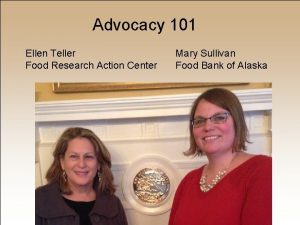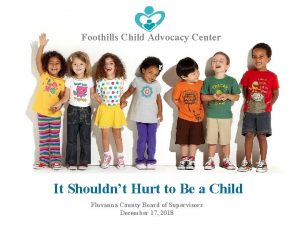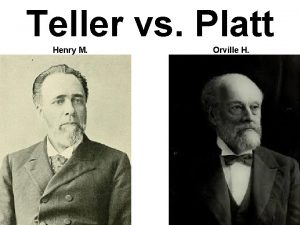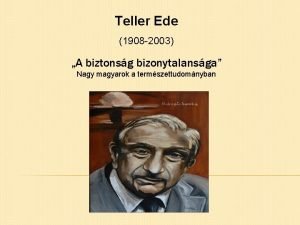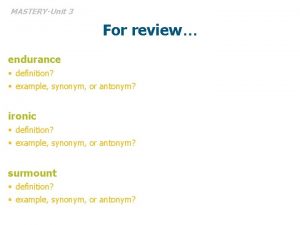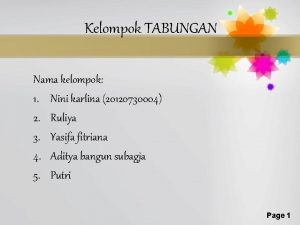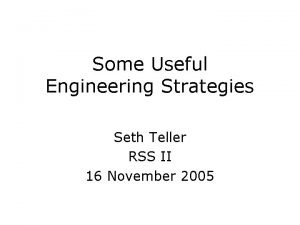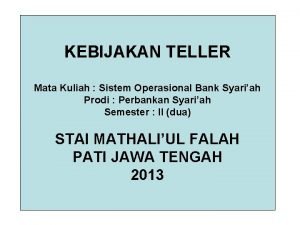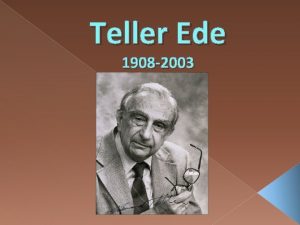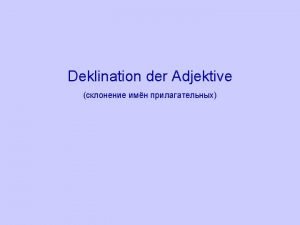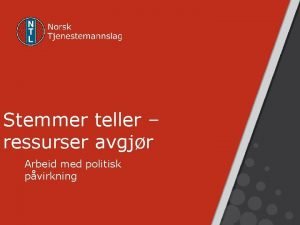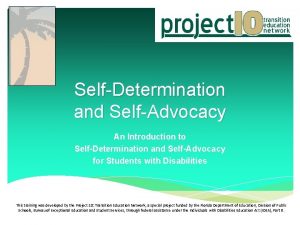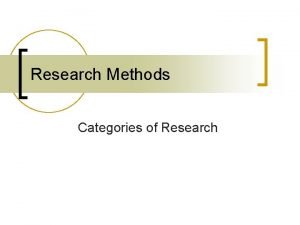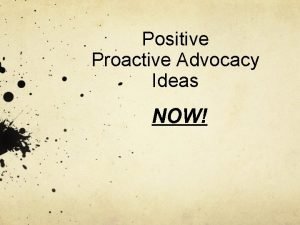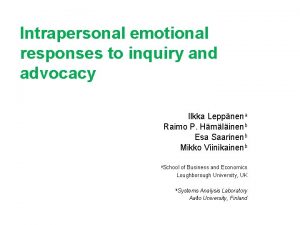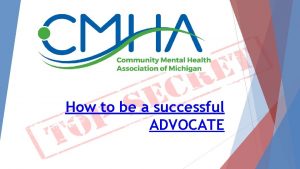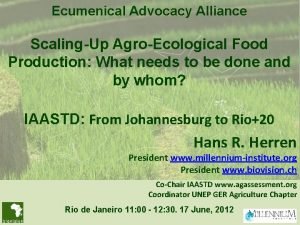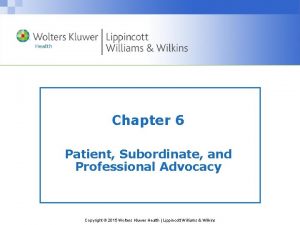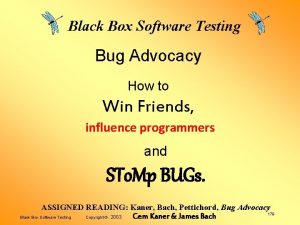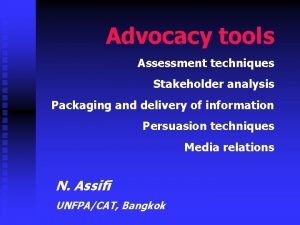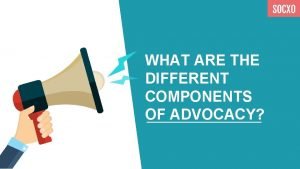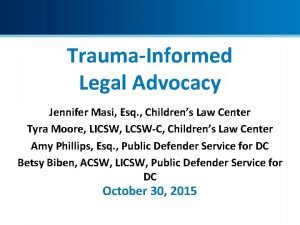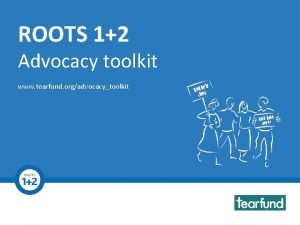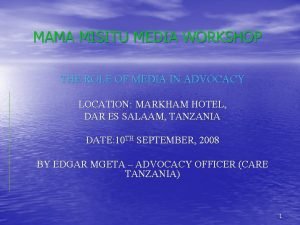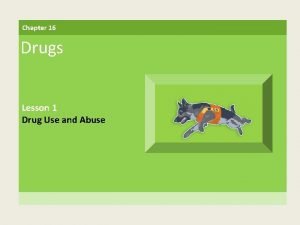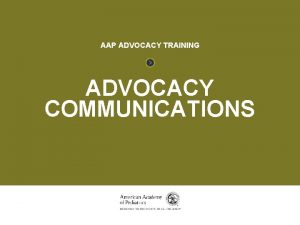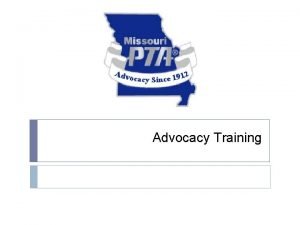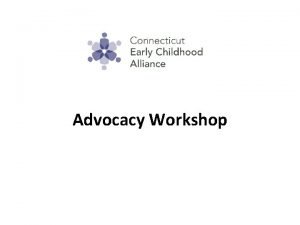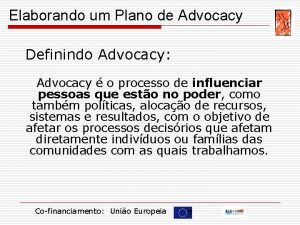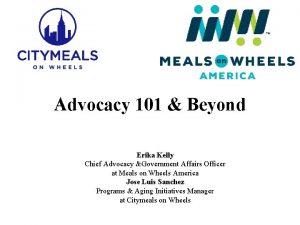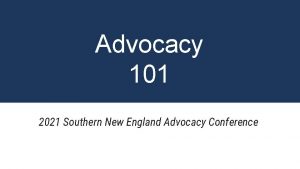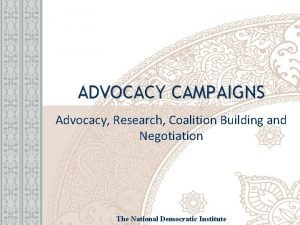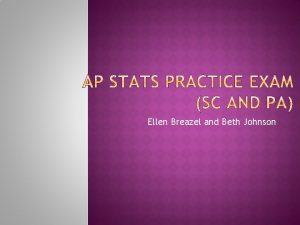Advocacy 101 Ellen Teller Food Research Action Center














































- Slides: 46

Advocacy 101 Ellen Teller Food Research Action Center Mary Sullivan Food Bank of Alaska

What is Policy? • What is Policy? Noun: policy; plural noun: policies. A course or principle of action adopted or proposed by a government, party, business, or individual.

Who Are Policy Makers? • Legislators (state legislators and federal) • State administrators • Municipal or borough leaders and staff • Internal agency/organization leadership, such as an ED or Board of Directors • *anyone who is in a position of power to influence a decision that impacts policy and/or your practice environment or issue topic*

What is Advocacy? • “Advocacy means giving a voice to an interest or need. Activities include educating community leaders on your issue, lobbying for specific legislative proposals, commenting on proposed regulations, and meeting with [various] boards [or commissions], to name a few. The target of your advocacy campaign will depend on your goal. You can choose to focus on a local community, a borough or municipality, a state and/or the federal government. The most successful advocacy campaigns recognize the interconnected layers where influence can be made, and effectively use the voices of staff, families…community leaders and others who share a common vision. ” --Healthy Families America

What is Diving In? • Definitions to get us on the same page. – What is “Diving In”? • Engaging the right advocates at the right time with the right message for the right “ask” of the right person/decision maker. It is calculated, but involves some “risk”. – What “Diving In” is not: • Reckless; lacking strategy, evidence & “human story” balance, or preparation. It is not “dangerous”.

Advocacy, Grassroots & Grasstops • Not necessarily interchangeable terms – Grassroots is one type of advocacy strategy that can include: • Coalition building, volunteer and community stakeholder mobilization • Paid media or earned media awareness campaign • Site visits or town halls or other public forums – Other strategies can include: • Testifying • Finding the right access point within the legislature to ask a question, provide a helpful piece of information etc. • Written support • Direct Action Organizing strategies

Community Leaders, Experts Coalitions, mass mobilization

What Keeps Us From Diving In? • • • Hesitancy (what are our fears? )… Time costs… Opportunity costs… Financial costs… Other? ?

Examples of Successful Advocacy Campaigns • Formation of Governor’s Food Resource and Development Working Group, passed House Resolution • Nutritional Alaskan Foods for Schools appropriations • Farm to School funding • 2014 Farm Bill – no cuts to SNAP for AK, protected other nutrition programs

Keys to Successful Advocacy • STRATEGIC – We must research and plan our campaign carefully. • SERIES OF ACTIONS – Advocacy is not simply one phone call, one petition, or one march but a set of coordinated activities. • DESIGNED TO PERSUADE – We must use ideas or provide arguments that convince people that the desired change is important and they will support it.

Keys to Successful Advocacy • TARGETED – We must aim our persuasion efforts at specific people who have the power to make our advocacy campaign successful • BUILD ALLIANCES – We must work with many stakeholders to increase the impact of our campaign. • RESULTS IN CHANGE – Our advocacy campaign must result in positive change in the lives of the people affected by the problem. For our advocacy to be effective we must persuade the targets of our advocacy campaign that we want is what they want

Keys to Successful Activism • Make your activism local and personal. – Local information: find local and specific information related to the policy ideas you support. Be sure to reference these figures in your letters and phone calls. – Local events: band together with other [stakeholders] and hold local events, highlighting the issues you care about. Invite your Member of Congress to participate in your events. – Local staff: build relationships with your Member of Congress’s local staff. They may be the key to getting relevant information and arguments in front of the real decision-maker.

Keys to Successful Activism, Cont’d. – Personable: effective activism should not be antagonistic and angry. Everyone likes to talk and work with people they like. Be likable! – Personal: as you build relationships with staff and your Members of Congress, be sure to emphasize your policy ideas and why you think this way

Direct Action Organizing • Framework to guide strategy building efforts – – – – A problem is identified and messaged as an “issue” Short and Long Term Goals Defined Assets and Challenges are Identified Action Steps are Identified Bring Many People to Face the Decision Maker Reacts Actions are Evaluated and Refined, Regroup

Who Do We “Bring”? • Depends upon the situation (political climate and other internal/external factors) – – – – Food Industry Leaders, Directors, CEOs Board Members Clinicians, Patients Consumers Farmers Schools Other Constituents or Community Stakeholders Whomever the decision maker listens to!

Engaging All Levels of Staff for Advocacy • “Most discussions of decision making assume that only senior executives make decisions or that only senior executives' decisions matter. This is a dangerous mistake. Decisions are made at every level of the organization, beginning with individual professional contributors and frontline supervisors. These apparently low-level decisions are extremely important in a knowledge-based organization. Knowledge workers are supposed to know more about their areas of specialization— for example, tax accounting—than anybody else, so their decisions are likely to have an impact throughout the company. Making good decisions is a crucial skill at every level. It needs to be taught explicitly to everyone in organizations that are based on knowledge. ” –Peter Drucker, Harvard Business Review

More on Engaging All Levels • “Those who build great companies understand that the ultimate throttle on growth for any great company is not markets, or technology, or competition, or products. It is one thing above all others: the ability to get and keep enough of the right people…The moment you feel the need to tightly manage someone, you've made a hiring mistake. The best people don't need to be managed. Guided, taught, led--yes. But not tightly managed. ”—Jim Collins, Good to Great for the Social Sectors

Legislative & Budget Process Resources • Legislative Process: http: //w 3. legis. state. ak. us/docs/pdf/legprocess. pdf • Budget Process: http: //w 3. legis. state. ak. us/docs/pdf/budgproc. pdf

Legislative Process/Flow • Legislator Idea for a or Gov. takes up Bill • Legal Bill Services Drafting • Assigned to staff for action First Regular Session Interim • Chief Clerk of House or Secy. Bill Of Senate or Introduced Rules Comm. • Bill assigned # Second Regular Session



BASIS Basics • http: //w 3. legis. state. ak. us/ v – Find most recent committee action – Follow certain Bills – Watch hearings (gavel to gavel) – Look up documents related to legislation – General information on AK Constitution and Legislative Process – Contact and Committee Information – LIO and Legislator/District Information

A Word About Persuasion • What persuades people effectively? – – – Values/Ideology Financial or other material realities Facts/Evidence Political realities External pressures Advice/perspectives from trusted sources • What tends to be less persuasive? – – Guilt Exaggerating facts Lack of accountability & follow-through Others?

Why Host A Visit • • Outreach and educate influential people Correct misconceptions New insights may influence the influencer! Your voice can be the difference in how this person prioritizes funding, interprets regulation, etc. • Your “boots on the ground” experience is VITALLY important – you are the expert!

Why Host a Visit? cont’d. • We want people of influence to care about food policy issues in their community so that they can: – Allocate funds – Remove barriers to services, farmers, consumers – Bring awareness in the community to other influential people, such as donors

Why Host a Visit? cont’d. • Policy makers WANT to hear from you. • They WANT the photo op. • They WANT to know about issues impacting their district!

Tools for Setting Up Visits • Checklists and templates from FRAC – http: //frac. org/leg-act-center/advocacy-tools/ • Checklists and templates from Western Region Organization of Resource Councils – http: //worc. org/How. To. Guides/

Please Don’t Ever Do’s • Never be critical of personalities: make your points about issues. • Never lose your cool: stay calm. • Never tell half-truths: don’t distort or conceal important facts. • Never waste a VIP’s time: be brief and to the point. • Never make public assumptions about another person’s motives.

Please Do! • Do have an extremely productive visit! • Do have others present with you who are knowledgeable on the issues you plan to discuss. • Do have others present with you who are influential and might grab the ear/attention of the policy maker

Please Do! Cont’d. • Do deal with only one (or at most two) issue(s) at a time • Do know relevant legislation and opposing views on your issue. • Do find common ground and be willing to consider a compromise. • Do express appreciation for the VIP’s work, support, time, etc.

Will You Commit? • Child Nutrition Reauthorization • Alaska Food Policy Council - State and Federal Legislation and Appropriations • Farm Bill Implementation • Alaska’s Food Economy Assessment

What is Child Nutrition Reauthorization? • Every 5 years, Congress reexamines the laws that govern child nutrition programs. There are three laws that govern the Child Nutrition Programs: – The Richard B Russell National School Lunch Act – The Child Nutrition Act of 1966 – The Child Nutrition and WIC Reauthorization Act of 2004. Public Law 108 -265 (which amended both the National School Lunch Act and the Child Nutrition Act). • Collectively these laws are referred to as the Child Nutrition Reauthorization bill, or “CNR”.

Which Federal Nutrition Programs are Part of CNR? • Special Supplemental Nutrition Program for Women, Infants and Children (WIC) • National School Lunch Program (NSLP) • School Breakfast Program (SBP) • Child and Adult Care Food Program (CACFP) • Summer Food Service Program (SFSP) • WIC Farmers Market Nutrition Program • Fresh Fruit and Vegetable Program (FFVP) • Special Milk Program

What Happened Last Time? • The expansion of afterschool suppers nationwide. • Elimination of caps on the number of sites and children nonprofit sponsors can serve through the Summer Food Service Program. • Simplified enrollment for low-income children in school meal programs. • Strengthening of nutrition standards for school meals and food sold in schools. • Strengthening of nutrition standards for Child and Adult Care Food Program.

Commit to CNR • To learn more about how to get involved with the advocacy efforts, email Mary Sullivan, Director of Advocacy and Agency Relations at msullivan@foodbankofalaska. org. • FRAC’s resource page for CNR – http: //frac. org/leg-act-center/cnr-priorities/


Alaska Food Policy Council • Food policies address, shape, or regulate the food system. They can promote or hinder safe, healthy, and effective food activities. • The role of the AFPC is to collaborate on mutually beneficial solutions to food system problems. Provide recommendations and information regarding comprehensive policies that improve Alaska’s food system.

Why Care About Alaska’s Food Policy and Food System?

Alaska Food Policy Council • Goal 1: All Alaskans have access to affordable, healthy (preferably local) foods. • Goal 2: Alaska’s food-related industries have a strong workforce and operate in a supportive business environment. • Goal 3: Food is safe, protected, and supplies are secure throughout Alaska. • Goal 4: Alaska’s food system is more sustainable. • Goal 5: Alaskans are engaged in our food system.

Farm Bill Implementation in AK • US Secretary of Agriculture, Tom Vilsac, calls it the food, farms, and jobs bill • Much, much larger than just the nutrition title or farm subsidies • $3. 5 B in USDA funded projects for Alaska, mostly for rural

Farm Bill Implementation in AK • • • Infrastructure Economic Development Potable Water projects Research Farming (and new farms) and Ranching Conservation

Farm Bill Implementation in AK • The Emergency Food Assistance Program • Commodity Supplemental Food Program • Supplemental Nutrition Assistance Program • Pilot projects for SNAP at farmer’s markets • Senior farmer’s markets and more

AK Food Economy Assessment • Ken Meter hired to do an assessment of Alaska’s Food Economy • Did town hall meetings all around the state, including some more rural areas • Collected input and assembled a report, complete with recommendations for how to strengthen our food system.

Recommendations • Ken’s report contains 9 areas of recommended action • These recommendations are posted around the room. • Voting on your top three preferred actions

“You must maintain unwavering faith that you can and will prevail in the end, regardless of the difficulties, AND at the same time, have the discipline to confront the most brutal facts of your current reality, whatever they might be. ”—Jim Collins

Thank you! Mary Sullivan, MSW msullivan@foodbankofalaska. org 907 -222 -3113
 Ellen teller frac
Ellen teller frac Foothills child advocacy center
Foothills child advocacy center Teller ede vers
Teller ede vers Teller vs platt amendment
Teller vs platt amendment Teller ede ppt
Teller ede ppt Alle teller lærerveiledning
Alle teller lærerveiledning Cardiorespiratory endurance synonym
Cardiorespiratory endurance synonym Flowchart menabung di bank
Flowchart menabung di bank Alicia has started a new and very different job
Alicia has started a new and very different job Gelijkwaardige breuken
Gelijkwaardige breuken Seth teller
Seth teller Teller bank syariah
Teller bank syariah Tempat pengukuran nadi
Tempat pengukuran nadi Smart teller machine
Smart teller machine Teller ede
Teller ede Welch deklination
Welch deklination Stemmer teller ressurser avgjør
Stemmer teller ressurser avgjør Unit 2 food food food
Unit 2 food food food Grazing food chain diagram
Grazing food chain diagram Kanbar center ucsf
Kanbar center ucsf Importance of advocacy in community
Importance of advocacy in community Self-determination worksheets pdf
Self-determination worksheets pdf What is self esteem
What is self esteem Quantitative research objectives examples
Quantitative research objectives examples Positive advocacy
Positive advocacy Iowa child advocacy match
Iowa child advocacy match Advocacy inquiry model
Advocacy inquiry model Lobby vs advocacy
Lobby vs advocacy Ecumenical advocacy alliance
Ecumenical advocacy alliance Subordinate advocacy
Subordinate advocacy Bug advocacy
Bug advocacy What is advocacy
What is advocacy Packaging and delivery of information in advocacy
Packaging and delivery of information in advocacy Advocacy about unemployment
Advocacy about unemployment Tetcho suehiro advocacy
Tetcho suehiro advocacy Advocacy advertising
Advocacy advertising Courageous advocacy powerpoint
Courageous advocacy powerpoint Components of advocacy
Components of advocacy Jennifer masi
Jennifer masi Student advocacy definition
Student advocacy definition Advocacy goals and objectives examples
Advocacy goals and objectives examples Advocacy pronunciation
Advocacy pronunciation What is advocacy cycle
What is advocacy cycle What is advocacy cycle
What is advocacy cycle Youth empowerment in the philippines
Youth empowerment in the philippines Advocacy brochure about drugs
Advocacy brochure about drugs Oregon self advocacy coalition
Oregon self advocacy coalition
